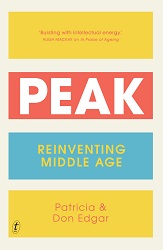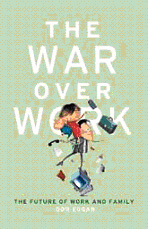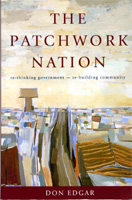
Patricia Edgar & Don Edgar

Meaningful participation – how to give the community a 'voice'
Don Edgar
Department for Community Development, Perth, June, 2003
_______________________________________________________________________
I have spent my entire life being involved in community activity and arguing for more involvement in government by the wider community.
When people say to me, but how do you get people involved, I have to go back to basics.
I am often told, 'people don't want to be involved', 'people are too busy these days', 'it always ends up with a few noisy ones dominating and the ordinary people left out', 'it's a middle class activity, you won't get anything from this lot'. And I have to say, 'Yes, it's not easy', but also 'Maybe you're expecting too much, or expecting the wrong things, because you have a middle class view of what real participation is.'
But we cannot begin to talk about community participation without first setting the context.
Why do we need a change?
Australia sits in a rapidly changing world and life is ever more complex. It is a world in part hostile to local communities because it is driven by a new form of 'turbo-capitalism' that doesn't give a damn about local jobs, or family life, or even the viability of the Australian (let alone State or regional) economy and culture. To my mind, that makes government (especially at State and local level) more, not less important. But it needs to be more intelligent government, one that is more responsive to the complex 'patchwork' of regions and localities with different resources, needs and interests that go to make up this 'Patchwork Nation'.
Complexity means one-size-fits-all will no longer work. We cannot have top-down services delivered to every patch in the same way, designed by people who don't know how diverse community needs are and don't care. The whole culture of the public service needs to be outward-, not inward-looking and we need new structures and processes that will break down the silos, build the capacity of communities to do things for themselves, in their own way, and put an end to the mentality of 'servicing'. There is a need to shift the power of decision-making, away from central managers and planners, to real communities where democracy and the civil society are re-built and democracy is 'thickened'.
We also have to assert a few principles.
First, people have a right to be involved in any decisions that will affect their everyday lives. We live in a democracy, not a dictatorship, and though, of necessity, we delegate a lot of decision-making authority to elected representatives, officials and experts, that does not give them carte blanche to determine what is best for us or how best to achieve the common good. Unfortunately, the culture of the public sector – by which I mean not just government public servants, but also the non-government community service agencies – is not always accepting of this right or structured in such a way as to guarantee I have a say in the many decisions that affect my life.
Just think about the practice of medicine. We often complain about doctors and their arrogance, their sense of superiority to us as patients. However, if I go to a doctor and he finds I have cancer, the first right I have as a patient is to be informed – about the diagnosis, about the likely course of the disease, about forms of treatment and ways of managing the consequences of that treatment. He can't simply order me to have an operation, or chemotherapy, or some alternative treatment he may prefer. It's my body, and I decide what can be done to it. Of course, I'll listen to his expert opinion, but I may seek a referral to a specialist or two to add to my information base.
I can only act on the basis of good information and access to good information is the first requirement for any form of community participation.
Next, I will discuss my options with several others – partner, family, friends, those who have been through a similar experience. In other words, I will network, put the pieces together, draw on a range of other resources to help me make a decision but (more importantly) to support me through the crisis and eventual treatment.
So the second requirement for participation is access to an appropriate network – preferably to many inter-locking networks which will together give me a 20/20 picture of where the problem sits and what can be done about it.
But both these steps in the participation process assume something else.
First, that I have the ability to seek out and to understand relevant information. If I am poorly educated, non-English-speaking, cannot read, do not have access to a telephone or the Internet, my ability to participate in any meaningful way is limited – I'm likely to just accept what I am told to do and I am a victim of my own ignorance.
Second, it assumes I have a family, some friends, a network or two that will expand my resources and ability to decide what is best. But if I am newly arrived in this neighborhood, or ostracized because of my culture or some disability, or confined to my home because of unemployment, poverty or caring responsibilities, then networking, checking things out with others, is hard to do. Isolation is the enemy of active participation.
Third, it implies that I have a 'voice', an ability to ask questions, challenge what I am told, to think for myself, weigh up the options and make an intelligent choice about what to do. And having a 'voice' is not enough unless other people 'listen', and listening (or, more importantly, 'hearing' what other people say, paying attention to it) is in short supply. Because we all speak and hear in different voices – our vocabulary may be limited, our questions may be vague, our ethnicity and language may limit how and what we ask, we may defer to or be expected to defer to 'expert' opinion, and many of us have had our 'voice' so stifled in the past by authoritarian parents, teachers, bosses and bureaucrats that it's more of a whisper than a shout.
That means the third requirement for participation is a listening context, a culture within the public service and within community organizations and workplaces which respects my peculiar voice and the diverse peculiarities of the voices of others. It cannot be a culture of disdain, of disrespect, of superiority. It must be one in which 'the way we do things around here' is listen actively to what we are being told by other people.
If I go back to my example of medicine and having cancer, there is another requirement before I can actively participate in the decision-making that will affect my life. That's money and/or control over how money will be spent in my treatment.
If I have private health insurance, I can shop around, seek other expert opinion, have the surgeon of my choice, in the hospital of my choice, at the time of my choosing. On the other hand, if I am poor, dependent on bulk-billing, Medicare and public hospitals, you could hardly say I have much chance of deciding how I will be treated. Look at all those poor people with terrible teeth who line up at the Dental Hospitals, having waited a few years to get fillings or a set of false teeth. Resources, and control over those resources, are vital to any form of participation.
To summarise what we've covered so far :
Involvement depends upon?
- Information – availability?
ability to use?
'voice'
- Networking
- A listening culture
- Control over resources
Now, let's go beyond the example of a private individual in need of medical treatment. Let's look at the so-called community as a whole and how we might best engage them in real participation.
At the wider community level, there are many barriers to public participation, and we have to be realistic about them.
Main barriers to engagement?
- time – both parents working/studying (Govt. and employers can give paid time off if they wanted to)
- times of meetings often do not take into account parents' situation
- logistical – transport, language issues, length of the family's stay in the local area
- attitudinal and cultural differences – re. child-rearing and communication styles – often derive from parents' own negative experiences of schooling
- lack of training of staff in how to build trusting, collaborative relationships with parents – time and frequency is often less important than the quality of the relationship with staff whenever they meet
The first step is to define exactly what is the community. If you start with the notion that community is one thing, you'll never get it right. There are always many different communities within any defined 'place'. Your best starting point is a 'place' where people have some interests in common. But that won't include everyone in that place. You have to start by doing a stakeholder analysis – who is/will be affected, and how? There's not much point in trying to engage the whole 'community' in every issue – they're not interested, don't have time, and you'll be doomed to fail.
Obviously, if you work with child care your first community is the community with the biggest vested interest – parents. You won't have much trouble engaging parents in decision-making about the child care curriculum, physical facilities, management structures. But how might you engage those not so directly interested, though vital to doing your work well? e.g. employers who won't give parents time off to participate in the centre or kindergarten? Or the grandparents who do most of the child-minding outside formal hours of care? Or the maternal child health nurse, family support worker, child protection officer, primary school teacher whose work supplements and complements your own? How do you draw in resources outside your own comfort zone that might make your job easier, improve the outcomes you are trying to achieve?
The answer again has to be pragmatic, practical, not overly grand. Start with the networks and connections that already exist. If the issue is children's and family services, then child care workers, disability workers, maternal and child health nurses, primary school teachers probably already talk to one another, at least have a common framework of concern for the wellbeing of children. Or if the issue is youth, then school teachers, parents, sports groups, police, etc. will form a common interest group.
But they may have no organized means of networking, of sharing information, getting together to exchange information. And you can develop those networks in very informal ways – lunchtime paper bag chats, at different venues; rotation dinners at one another's homes; swapping duties with some so they see how the others work and the problems they face; shared administration for staff recruitment, buying of supplies, sorting applications for and assignment of child care places. You don't always have to have meetings, or conferences, or public forums.
Especially with parents or clients, it's often better to start small – with home visits one-on-one, helping small groups of parents to get together, not just in play groups, but in parks or playgrounds, McDonalds or other shopping centres, with a clear purpose – to examine how suitable they are for children, work out what is missing, what they would like their children to experience, how things might be improved. They can be given a simple check-list of 'child-friendly' or 'family-friendly' characteristics, to be used as a stimulus to discussion – 'voice' – and as a starting point for active participation.
But you need to think first about what 'participation' means – it's not just one thing; there are several levels of engagement and all can be legitimate things to aim for.
Another way of putting this is to say there are four main levels of participation or engagement:
It is always important to make clear, at the outset, what level of participation is possible, what is being asked for, what people can realistically expect. Otherwise, expectations are raised too high, the community finds it has little influence and no real power, and distrust and cynicism set in, making any future participation even less likely.
Let me give you some examples of how community participation can work, and the processes involved. These are drawn first from my own experience, then I will mention some models from overseas that we might think of adapting to conditions in Australia. None of it is easy.
The key was to insist that area communities identify 'resources', not just 'needs'. At first, they denied they had any resources, but when we asked what skills people had, what special knowledge, what tools, facilities, musical instruments, arts materials, etc. they had, they could see a wealth of resources to build on. Those artificially-defined 'areas' did become communities, and the programs and morale they developed for themselves continue to this day, some twenty years later.
The New Links Workplace idea grew out of my work with companies wanting to become more 'family-friendly'. I decided that no matter how good their internal policies were, if the communities in which their employees lived were not supportive of family life, the company's efforts would be thwarted. So we got them to do a 'Community Scan' of existing family support services, gaps, needs, and then to act politically to improve them. Alcoa, Australia Post, Lend Lease and others were thus able to forge new links with local government, schools, and family support agencies, bringing them in to the workplace to operate in more immediate ways. They also lobbied for better child care, aged care and youth facilities across their communities, thus improving the 'family-friendliness' not only of their work sites but also for the entire town/region.
In both these examples, the essence of the process was listening – giving people a 'voice' through questionnaires, focus groups, information dissemination and exchange, using information as a means of changing the culture, changing the way people were thinking, so that new, more participatory mechanisms could be set up. Both of them involved not just talking about needs and gaps, and what people wanted done for them, but also talking about resources, the skills and ideas, physical and people resources that could be built on.
And in both cases, the amount of money needed to improve matters turned out to be much less that anyone had expected. Greater efficiency, transparency and accountability were the result, and, most of all, the outcomes were obvious and were measured, not just the 'inputs' and 'outputs' of the usual bureaucratic kind.
Successful methods of consultation and community involvement are therefore not just the traditional ones of setting up committees and having public meetings. As I hope I've illustrated, communities have significant knowledge resources and they are too often untapped. So you have to look beyond the old formalities. In fact, public meetings are not the most effective way to involve people. The most effective way is to give them a task to do, preferably one that is straightforward and simple, not too demanding of time, and one which makes them see their problems in a new light, one that is shared and might be met by sharing resources, not simply demanding more of the same. In doing so, you empower them and give them 'voice'.
Methods of consultation?
- Look beyond traditional c'tees and public meetings
- Identify the community's on untapped knowledge/resources
- Simple rather than complex
- Start where they are, not where you are
- Use their venues, not yours – give the excluded a 'voice'
- Set a clear time-frame – Stage 1 open-ended Stage 2 – specific purpose
- Expect the unexpected, will be difficult, adapt as you go along
- Focus groups – find what's important, open-ended but with clear issues
- Workshops – use mind maps, scenario-building, visioning, storyboarding, open-space café, passion café
- Area/neighborhood Forums – meet regularly on defined issues
- Open house Roadshows/exhibitions – go to people, get reactions
- Information Hotline
- Representative groups – capitalize on existing networks, feedback
- Q'res and Surveys – costly, may not tell you 'why' feel that way
- Deliberative opinion polls – only get Yes/No
- Advisory C'tees – need to be representative, accountable
- Design Meetings/Charettes – post-it notes, relies less on literacy \
- Accept but manage conflict
- Promote dialogue, not monologue
- Use 'we' talk, not 'us' vs 'them'
- Ask what worked, what didn't, and why
The key is 'active listening', where the professionals empathise and accept people's feelings, show patience and respect. Avoiding jargon, body language that reveals disdain or discomfort, using their venues, not your own, talking first with those most closely involved with an issue, expecting, accepting but managing conflict so you don't fuel divisions and instead build on areas of agreement and mutual interest, promoting 'we' talk, not 'us' versus 'them', asking what worked in the past and why/why not, promoting dialogue, not monologue are all crucial techniques.
They can be learned, and the message for government trying to devolve, to consult, to engage communities in the way public money is spent on services, is that they have to train their workers, not simply throw them to the wolves and expect them to know how to engage the community in such processes.
Let me finish by listing a set of new principles for a new public service culture, principles that embody what I have tried to illustrate today:
Examples of real involvement?
Italy, Netherlands, Portugal – parents control ECEC staffing and budgets – new partnerships
Netherlands – 'broad-based schools' to access the whole range of children's services – grew from the bottom up, wide range of forms adapted to needs of different municipalities – stay open at night too for cultural and adult education
England – Early Excellence Centres
Italy – nuove tipologie services aimed at giving more flexible learning and socialization opportunities for children who don't need full-time child care
- suits non-working or P/T parents
- suits immigrants – help adapt and develop networks and language skills
Capabel Project, Amsterdam – 32,000 immigrant district
- mobilize and coordinate existing organizations and draw attention to actual needs of the target groups
- aims to minimize the number of children entering school with developmental delays
- provides a crèche and tutoring for mothers to learn language
- local district council support (one Govt. member only on Steering C'tee)
References:
Amato, P. & A. Booth (1997), A Generation at Risk: Growing up in an Era of Family Upheaval, Narvard University Press
Edgar, Don (2002), The Patchwork Nation: Re-thinking government, Re-building community, Harper Collins, Sydney
Edgar, Don (1999), Promoting the Positive: Developing a Rationale for an Ideal Service System for Families, Deakin Human Services. (Reprinted by Victorian Children's Welfare Association)
,
Frydenberg, E. (ed.) (1999), Learning to Cope: Developing as a Person in Complex Societies, Oxford University Press
Latham, Mark (2003), From the Suburbs: Building a Nation From Our Neighborhoods, Pluto Press, NSW
Local Government Community Services Association of Australia (1999), Working Together to Develop Communities, Commonwealth Dept. of Transport and Regiional Services,Canberra
Local Government Community Services Association (2002), Making it Real: A Resource for Community Consultation, www.lgcsasa.asn.au
OECD (2001), Cities and Regions in the New Learning Economy, OECD, Paris
The Stegley Foundation (1998), Community Audit, A Resource Guide for Building Better Communities, People Together Project, Stegley Foundation, Melbourne









